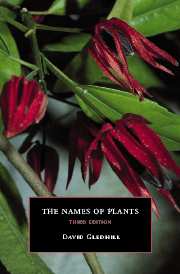Book contents
- Frontmatter
- Contents
- Preface to the first edition
- Preface to the third edition
- The nature of the problem
- The size of the problem
- Towards a solution to the problem
- The rules of botanical nomenclature
- The International Code of Nomenclature for Cultivated Plants
- Botanical terminology
- The glossary
- Addendum to glossary
- Bibliography
Preface to the third edition
Published online by Cambridge University Press: 06 July 2010
- Frontmatter
- Contents
- Preface to the first edition
- Preface to the third edition
- The nature of the problem
- The size of the problem
- Towards a solution to the problem
- The rules of botanical nomenclature
- The International Code of Nomenclature for Cultivated Plants
- Botanical terminology
- The glossary
- Addendum to glossary
- Bibliography
Summary
Since making the assumption, in the second edition, that genetic manipulation of the properties of plants might require new consideration of the ways in which they are to be named, GM has proceeded apace. Not only can the innate genetic material be re-ordered – in ways that nature would have rejected through their exposure to natural selection by the environment – but alien genetic material, from other organisms, can be introduced to give bizarre results. Arabidopsis thaliana has only 10 chromosomes and has been the plant of choice for cytologists and nucleic acid workers because of this. The twenty-first century sees its genetic code mapped and its 25, 000 genes being examined individually to ascertain the ‘meaning of plant life’. From quite practical beginnings such as giving tomato fruits an extended keeping time, to esoteric developments such as building a luminescence gene from a jellyfish into a mouse, there is now a proposal to insert a gene from an electric eel into plants so that the plants can provide sources of electricity. This new ‘green revolution’ has an historical ring of familiarity about it!
The new century has not yet brought universal consistency in accepting the botanical and the horticultural codes. Yet science is already seeking to move towards an international biodiversity code for the naming of everything.
- Type
- Chapter
- Information
- The Names of Plants , pp. ix - xPublisher: Cambridge University PressPrint publication year: 2002



